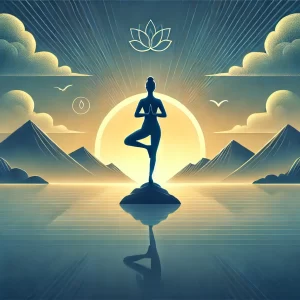
“Morning vs. Evening Yoga: Which is More Beneficial?”

Yoga is a timeless practice that nurtures the mind, body, and soul — but when is the best time to roll out your mat? Should you start your day with sun salutations or wind down with an evening flow? The truth is, both morning and evening yoga have unique benefits. Let’s dive into this head-to-head comparison to help you decide which time suits you best.
Morning Yoga: Energize Your Day
1. Boosts Energy Levels
- Morning yoga wakes up your body and mind, shaking off sluggishness. Dynamic poses like Sun Salutations (Surya Namaskar) improve blood flow, leaving you feeling invigorated and ready to conquer the day.
2. Enhances Metabolism
- Starting your day with movement fires up your digestive system, helping your body metabolize food more efficiently. Poses like Boat Pose (Navasana) and Twisting Chair Pose (Parivrtta Utkatasana) stimulate the core and aid digestion.
3. Sharpens Mental Focus
- Morning flows, paired with mindful breathing, activate the brain. Tree Pose (Vrikshasana) and Warrior Poses (Virabhadrasana) enhance balance and concentration — a perfect mental prep for a productive day.
4. Creates a Positive Mindset
- Beginning your day with calming poses like Child’s Pose (Balasana) and Seated Meditation (Sukhasana) fosters a sense of gratitude and peace. You start your day on a high note, radiating positivity.
5. Supports Consistency
- Morning routines are easier to stick to before the day gets hectic. A quick 20-minute morning session can become a lasting, healthy habit.
Best Morning Yoga Poses:
- Sun Salutations (Surya Namaskar)
- Downward-Facing Dog (Adho Mukha Svanasana)
- Warrior II (Virabhadrasana II)
- Cobra Pose (Bhujangasana)
- Tree Pose (Vrikshasana)
🌙 Evening Yoga: Unwind and Relax
1. Relieves Stress and Tension
- Evening yoga helps shake off the day’s physical and emotional stress. Cat-Cow Pose (Marjaryasana-Bitilasana) and Legs Up the Wall (Viparita Karani) ease muscle tension and promote relaxation.
2. Promotes Better Sleep
- Gentle, restorative evening flows signal your nervous system to wind down. Forward bends and supine twists activate the parasympathetic nervous system, preparing your body for restful sleep.
3. Enhances Flexibility
- After a day of movement, your muscles are naturally warmer. Evening practice allows deeper stretching, improving flexibility. Poses like Seated Forward Bend (Paschimottanasana) and Pigeon Pose (Eka Pada Rajakapotasana) feel more accessible and rewarding.
4. Mental Detox
- Evening yoga lets you clear the mental clutter accumulated throughout the day. Incorporating Pranayama (breathwork) and meditative poses helps release worries, fostering mental clarity.
5. Aids Digestion
- A gentle evening sequence supports your digestive system after meals. Twists help alleviate bloating and promote gut health — just be sure to wait 2-3 hours after eating before hitting the mat.
Best Evening Yoga Poses:
- Cat-Cow Pose (Marjaryasana-Bitilasana)
- Seated Forward Bend (Paschimottanasana)
- Reclining Twist (Supta Matsyendrasana)
- Legs Up the Wall (Viparita Karani)
- Corpse Pose (Savasana)
Choose based on your goals and lifestyle — morning for energy and focus, evening for relaxation and sleep
Can’t Decide? Mix Both!
Why choose one when you can enjoy both? A quick, energizing morning flow followed by a gentle evening unwind offers the best of both worlds. For example:
- Morning: 15-20 minutes of Sun Salutations, standing poses, and core work.
- Evening: 10-15 minutes of deep stretches, twists, and relaxation poses.
Tips for Evening Yoga:
It’s generally not recommended to do intense yoga right after eating, but gentle evening yoga can be beneficial — especially for relaxation and digestion. If you’ve had a heavy meal, it’s better to wait at least 1-2 hours before practicing.
If you still want to stretch and unwind, here are a few light yoga poses that are safe and soothing after food:
- Vajrasana (Thunderbolt Pose) – This is one of the few poses traditionally recommended after eating. It supports digestion by improving blood flow to the stomach.
- Supta Baddha Konasana (Reclining Butterfly Pose) – Helps open the hips and encourages relaxation.
- Balasana (Child’s Pose) – Relieves bloating and promotes calmness.
- Viparita Karani (Legs-Up-The-Wall Pose) – Supports blood flow and reduces fatigue.
- Savasana (Corpse Pose) – A perfect way to wind down, focus on your breath, and prepare for restful sleep.
Final Thoughts: Find Your Flow
Whether you’re an early bird or a night owl, yoga fits beautifully into any schedule. The key is to listen to your body — mornings may fuel your day with energy, while evenings help melt away stress.
So, what’s your vibe? Will you start strong with morning yoga or relax into evening bliss? Let us know your favorite time to practice!
Ready to commit to a daily yoga routine? Check out our other guides on creating the perfect home yoga space and mastering essential poses for beginners.